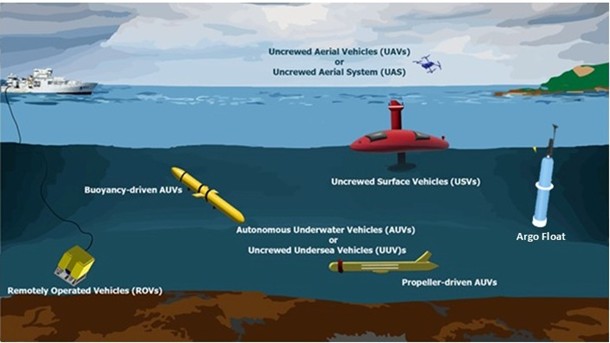Uncrewed Systems
Uncrewed systems (UxS) are platforms that can be manually controlled or operate autonomously. Guidance for the manually controlled vehicles can range from remote operation in real-time to pre-programmed control of its path or task.
UxS range in size from that of a mobile phone to a tractor trailer and can be equipped with a variety of power sources (e.g., solar, rechargeable, and diesel). Individual vehicles can complete tasks or work in coordination with other vehicles.

Adapted from NOAA Uncrewed Systems Operations (https://www.omao.noaa.gov/uncrewed-systems/about-noaa-uncrewed-systems-operations)
Uncrewed Aerial Vehicles (UAVs), also called Uncrewed Aerial Systems (UASs), can be launched from a plane, ship, or land. Some take off and land like a plane, others move like a helicopter, and some are hybrid models. Onboard instruments can record imagery, take scientific samples, and perform other activities. Communication with these systems is usually via radio/WiFi.
Autonomous Underwater Vehicles (AUVs), also called Uncrewed Undersea Vehicles (UUVs) or Uncrewed Marine Systems (UMSs), can be launched from a ship or land. Uncrewed marine systems include surface and underwater vehicles. Some are remotely operated and tethered to ships, while others are autonomous. These systems can be powered by cables, diesel engines, batteries, solar power, fuel cells, and/or wind power. Some have long endurances and can operate for months. The onboard instruments can record data in the atmosphere, at the air-sea interface, throughout the water column, and on the seafloor. Vehicle categories include:
- Uncrewed Surface Vehicles
- Buoyancy-driven Autonomous Gliders
- Propeller-driven Autonomous Underwater Vehicles
- Remotely Operated Vehicles
- Floats
References
National Oceanic and Atmospheric Administration. Office of Marine and Aviation Operations. About NOAA Uncrewed Systems Operations. https://www.omao.noaa.gov/uncrewed-systems/about-noaa-uncrewed-systems-operations
Patterson, R. et al. 2025. Uncrewed Surface Vehicles in the Global Ocean Observing System: A New Frontier for observing and monitoring at the air-sea interface. Front. Mar. Sci. Vol 12 – 2025 | doi: 10.3389/fmars.2025.1523585